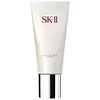What's inside
What's inside
 Key Ingredients
Key Ingredients

 Benefits
Benefits

 Concerns
Concerns

 Ingredients Side-by-side
Ingredients Side-by-side

Water
Skin ConditioningGalactomyces Ferment Filtrate
HumectantButylene Glycol
HumectantPolysorbate 20
EmulsifyingGlycerin
HumectantSodium Hyaluronate
HumectantPEG-150
HumectantCellulose Gum
Emulsion StabilisingDisodium EDTA
Citric Acid
BufferingSalicylic Acid
MaskingLactic Acid
BufferingMalic Acid
BufferingSodium Citrate
BufferingSodium Benzoate
MaskingMethylparaben
PreservativeIllite Extract
Skin ConditioningWater
Skin ConditioningGlycerin
HumectantStearic Acid
CleansingSorbitol
HumectantMyristic Acid
CleansingPEG-6
HumectantPEG-32
HumectantPotassium Hydroxide
BufferingLauric Acid
CleansingPEG-20 Glyceryl Isostearate
Sodium Methyl Cocoyl Taurate
CleansingLauryl Betaine
CleansingGlyceryl Stearate Se
EmulsifyingBeeswax
Emulsion StabilisingPolyquaternium-39
Tocopherol
AntioxidantPEG/PPG-14/7 Dimethyl Ether
Skin ConditioningParfum
MaskingSilica
AbrasiveDisodium EDTA
Trehalose
HumectantButylene Glycol
HumectantPEG-90m
Emulsion StabilisingSodium Benzoate
MaskingTheanine
EmollientSodium Metabisulfite
AntioxidantPEG/PPG-36/41 Dimethyl Ether
Skin ConditioningCI 77492
Cosmetic ColorantSodium Polyacrylate
AbsorbentRubus Idaeus Fruit Extract
AstringentDiamond Powder
AbrasiveSerine
MaskingGlycine
BufferingTremella Fuciformis Polysaccharide
Emulsion StabilisingCI 77491
Cosmetic ColorantSodium Acetylated Hyaluronate
HumectantSodium Hyaluronate
HumectantBHT
AntioxidantAngelica Acutiloba Root Extract
Skin ConditioningHydrolyzed Silk
HumectantHydrolyzed Conchiolin Protein
Skin ConditioningPerilla Ocymoides Leaf Extract
TonicWater, Glycerin, Stearic Acid, Sorbitol, Myristic Acid, PEG-6, PEG-32, Potassium Hydroxide, Lauric Acid, PEG-20 Glyceryl Isostearate, Sodium Methyl Cocoyl Taurate, Lauryl Betaine, Glyceryl Stearate Se, Beeswax, Polyquaternium-39, Tocopherol, PEG/PPG-14/7 Dimethyl Ether, Parfum, Silica, Disodium EDTA, Trehalose, Butylene Glycol, PEG-90m, Sodium Benzoate, Theanine, Sodium Metabisulfite, PEG/PPG-36/41 Dimethyl Ether, CI 77492, Sodium Polyacrylate, Rubus Idaeus Fruit Extract, Diamond Powder, Serine, Glycine, Tremella Fuciformis Polysaccharide, CI 77491, Sodium Acetylated Hyaluronate, Sodium Hyaluronate, BHT, Angelica Acutiloba Root Extract, Hydrolyzed Silk, Hydrolyzed Conchiolin Protein, Perilla Ocymoides Leaf Extract
 Reviews
Reviews

Ingredients Explained
These ingredients are found in both products.
Ingredients higher up in an ingredient list are typically present in a larger amount.
Butylene Glycol (or BG) is used within cosmetic products for a few different reasons:
Overall, Butylene Glycol is a safe and well-rounded ingredient that works well with other ingredients.
Though this ingredient works well with most skin types, some people with sensitive skin may experience a reaction such as allergic rashes, closed comedones, or itchiness.
Learn more about Butylene GlycolDisodium EDTA plays a role in making products more stable by aiding other preservatives.
It is a chelating agent, meaning it neutralizes metal ions that may be found in a product.
Disodium EDTA is a salt of edetic acid and is found to be safe in cosmetic ingredients.
Learn more about Disodium EDTAGlycerin is already naturally found in your skin. It helps moisturize and protect your skin.
A study from 2016 found glycerin to be more effective as a humectant than AHAs and hyaluronic acid.
As a humectant, it helps the skin stay hydrated by pulling moisture to your skin. The low molecular weight of glycerin allows it to pull moisture into the deeper layers of your skin.
Hydrated skin improves your skin barrier; Your skin barrier helps protect against irritants and bacteria.
Glycerin has also been found to have antimicrobial and antiviral properties. Due to these properties, glycerin is often used in wound and burn treatments.
In cosmetics, glycerin is usually derived from plants such as soybean or palm. However, it can also be sourced from animals, such as tallow or animal fat.
This ingredient is organic, colorless, odorless, and non-toxic.
Glycerin is the name for this ingredient in American English. British English uses Glycerol/Glycerine.
Learn more about GlycerinSodium Benzoate is a preservative. It's used in both cosmetic and food products to inhibit the growth of mold and bacteria. It is typically produced synthetically.
Both the US FDA and EU Health Committee have approved the use of sodium benzoate. In the US, levels of 0.1% (of the total product) are allowed.
Sodium benzoate works as a preservative by inhibiting the growth of bacteria inside of cells. It prevents the cell from fermenting a type of sugar using an enzyme called phosphofructokinase.
It is the salt of benzoic acid. Foods containing sodium benzoate include soda, salad dressings, condiments, fruit juices, wines, and snack foods.
Studies for using ascorbic acid and sodium benzoate in cosmetics are lacking, especially in skincare routines with multiple steps.
We always recommend speaking with a professional, such as a dermatologist, if you have any concerns.
Learn more about Sodium BenzoateSodium Hyaluronate is hyaluronic acid's salt form. It is commonly derived from the sodium salt of hyaluronic acid.
Like hyaluronic acid, it is great at holding water and acts as a humectant. This makes it a great skin hydrating ingredient.
Sodium Hyaluronate is naturally occurring in our bodies and is mostly found in eye fluid and joints.
These are some other common types of Hyaluronic Acid:
Learn more about Sodium HyaluronateWater. It's the most common cosmetic ingredient of all. You'll usually see it at the top of ingredient lists, meaning that it makes up the largest part of the product.
So why is it so popular? Water most often acts as a solvent - this means that it helps dissolve other ingredients into the formulation.
You'll also recognize water as that liquid we all need to stay alive. If you see this, drink a glass of water. Stay hydrated!
Learn more about Water